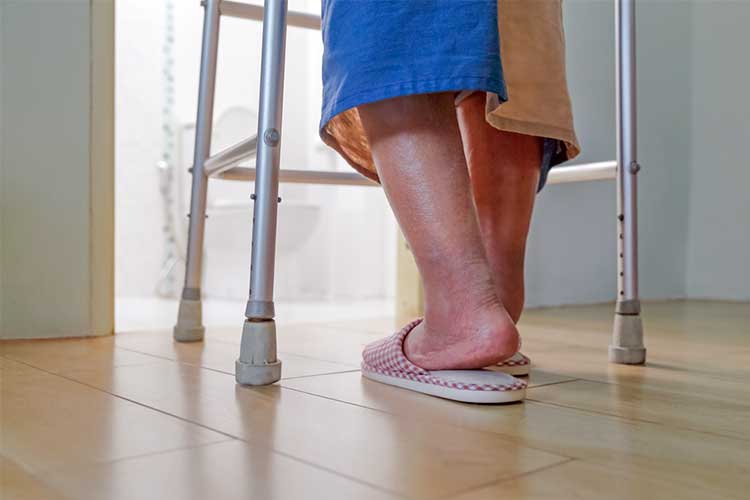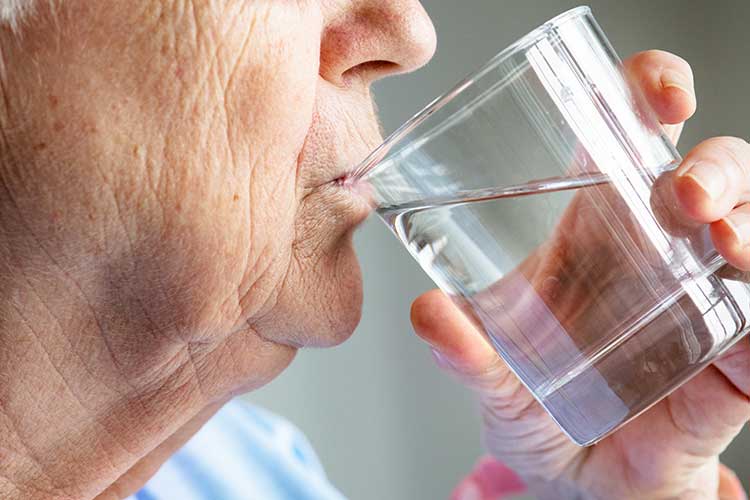Incontinence is estimated to affect about one in four people aged over 15, and over 5 million Australians overall (Continence Foundation of Australia 2024a).
What is Incontinence?
Incontinence is the involuntary loss of bladder and/or bowel control. There are two categories of incontinence:
- Urinary incontinence - the involuntary loss of urine from the bladder
- Faecal incontinence - the involuntary loss of faeces or wind from the bowel.
(Continence Foundation of Australia 2024a)
Living with incontinence can be both challenging and exhausting. Generally, the physical effects of incontinence are non-life threatening, however, consequences such as the sequelae of falls, urinary tract infections (UTIs) and delirium may have life-shortening effects (Bostock 2023).
Incontinence can affect people of all genders, ages and backgrounds. While the symptoms of this disorder are often not visible, incontinence can considerably impact a person’s quality of life and cause embarrassment that prevents them from seeking help (Better Health Channel 2021).
Fortunately, incontinence can be treated, managed, and, in many cases, cured.
Types of Incontinence
There are different types of incontinence and each has a number of possible causes. The most common are:
- Stress incontinence - the leakage of small amounts of urine caused by activities that increase pressure inside the abdomen and push down on the bladder, e.g. coughing, running, heavy lifting
- Urge incontinence - a sudden and strong need to void, followed by leakage
- Retention - the inability to fully empty the bladder
- Functional incontinence - where there are no physiological issues, but the person is unable to access a toilet due to physical, intellectual or environmental factors.
(Better Health Channel 2021; Continence Foundation of Australia 2024b)

Risk Factors for Incontinence
- Pregnancy or history of pregnancy
- Menopause
- Obesity
- Urinary tract infection (UTI)
- Constipation
- Specific surgeries, including prostatectomy and hysterectomy
- Mobility impairment that prevents the person from accessing a toilet
- Neurological and musculoskeletal conditions (e.g. multiple sclerosis, arthritis)
- Certain chronic conditions (e.g. diabetes, stroke, heart conditions, respiratory conditions, prostate problems)
- Certain medicines.
(Continence Foundation of Australia 2024a)
Symptoms of Incontinence
A person with incontinence might experience some of the following symptoms:
- Leaking from the bladder or bowels
- Leaking when they cough, sneeze or laugh
- Leaking on the way to the toilet
- Frequently needing to pass urine
- Needing to rush to the toilet
- Getting out of bed in the middle of the night to pass urine
- Bedwetting
- Feeling as if their bladder isn’t fully empty after voiding
- Poor urine flow
- Straining to empty the bladder or bowels
- Frequent UTIs
- Difficulty controlling flatulence
- Leaking from the bowels after passing wind.
(Better Health Channel 2021)
How Serious is Incontinence?
Incontinence is a distressing, symptom-based disorder. If left untreated it can result in a profound loss of quality of life; affect sexuality, relationships, mental health and wellbeing; and cause social isolation and institutionalisation.
Creating a Continence Management Plan
Creating a management plan with the patient and their family is the first step to addressing incontinence. The following should be taken into account:
- A comprehensive medical history
- Food and fluid consumption
- Bowel health
- Level of mobility and function
- Bladder function
- Hormonal balances.
(Bostock 2023)
The success of the management plan hinges upon the patient’s trust and confidence in the continence advisor. Once this is established, this lends validity and value to the delivery of the management plan (Bostock 2023).
Management Plan Considerations
The management plan coordinates nurse expertise with an individual’s needs; offers clear guidelines, milestones and progress measurements; and provides support and encouragement.
Careful consideration will ensure the patient and/or their family will have ownership of the outcomes, direct the course of the plan, and decide which modifiable risk factors can be ameliorated and which are non-negotiable. Non-negotiables may include the type of food and drink they consume or the medicines they take (Bostock 2023).
In the assessment phase, discuss which aspects of incontinence are the most bothersome to the patient. Ask them to consider the following:
- Social isolation
- Embarrassment
- Cost of continence aids
- Amount of laundry
- Changes in quality of life
- Changes to sexual health and intimacy
- The inability to engage in an activity that causes incontinence.
(Bostock 2023)
Management Strategies

Remember that every patient will need individualised strategies to account for factors such as age, gender, state of health, fluid restrictions, level of activity, function and mobility (Bostock 2023).
Fluid
Water should form the majority of fluid intake, and caffeine-based drinks such as coffee, tea and soft drinks should be limited (NHS 2023).
Alcohol should only be consumed in moderation as it can contribute to the incidence of urinary incontinence. This is because alcohol acts as a diuretic and bladder stimulant (Mayo Clinic 2023).
Advise patients to reduce fluids one hour before sleep (Bostock 2023).
Bowel Health Monitoring
Constipation is known to contribute to the incidence of urinary incontinence. The pressure of an impacted rectum against the bladder causes overactivity and possible leakage. Therefore, it is important to include the management of bowel health in the management plan (Continence Foundation of Australia 2024c).
Exercise and Physical Health
Activity, exercise and energy expenditure are very important. Exercise promotes strength and mobility, and the ability to access the toilet independently is important for maintaining quality of life (Bostock 2023).
Continence Aids and Equipment Available

Ensure the patient has all the aids, equipment and appliances required to fully support their mobility and function.
It’s crucial that this equipment is regularly serviced and maintained. An occupational therapist or physiotherapist may be required to do a home and equipment assessment (Bostock 2023).
Aids and equipment required by the patient may include:
- A walking frame
- A toilet raise
- Grab rails
- Non-slip mats
- Containment products
- Bed or chair protection
- Urine collection devices.
(Bostock 2023)
Toileting, Bladder and Bowel Programs
Toileting programs are useful for regulating voiding patterns, as they can prompt people to visit the toilet at set intervals. The program should be based on the outcome of a bladder diary, a person’s patterns and their fluid intake (Bostock 2023).
Bladder and bowel retraining programs can be used by any person living with incontinence. The program will be developed in conjunction with the individual and their family. The program may encourage the person to extend the time in between voids; include pelvic floor therapy and bowel retraining therapy aimed to increase anal sphincter tone; and encourage routine emptying of the bowel (Bostock 2023).
Pelvic floor therapy is a conservative treatment option. The program aims to develop or further support the tone and flexibility of the pelvic musculature, ligaments and viscera to decrease episodes of urinary incontinence (Bostock 2023).
What Does Optimum Bladder and Bowel Health Look Like?
Habits of a healthy bladder:
- Empties four to six times each day (every three to four hours)
- Is able to hold up to 400 to 600 ml of urine (the sensation of needing to void occurs at 200 to 300 ml)
- May cause you to wake up once at night to pass urine and twice if you are older (over 65 years of age)
- Lets you know when it is full but gives you enough time to find a toilet
- Completely empties completely each time you pass urine
- Does not leak urine.
(Continence Foundation of Australia 2024d)
Habits of a healthy bowel:
- Allow you to hold on for a short time after you feel the first urge to go to the toilet
- Passes a bowel motion within about a minute of sitting down on the toilet
- Passes a bowel motion easily and without pain - ideally, you shouldn’t be straining on the toilet or struggling to pass a bowel motion
- Completely empties when it passes a motion - you don’t have to go back to the toilet soon after to pass more.
(Continence Foundation of Australia 2024e)
Conclusion
Incontinence is a relatively common, treatable condition. Dignity and privacy should be key considerations in developing a management plan intended to aid a patient in achieving continence.
Your intervention could make a considerable improvement to a patient’s continence management, and therefore, make a drastic improvement to their overall quality of life.
Test Your Knowledge
Question 1 of 3
Approximately how much urine can a healthy bladder hold?
Topics
References
- Better Health Channel 2021, Incontinence and Continence Problems, Victoria State Government, viewed 19 September 2024, https://www.betterhealth.vic.gov.au/health/conditionsandtreatments/incontinence-and-continence-problems
- Bostock, N 2023, 'Management of Urinary Incontinence', Ausmed, 19 October, viewed 19 September 2024, https://www.ausmed.com.au/cpd/courses/urinary-incontinence
- Continence Foundation of Australia 2024a, Understanding Incontinence, Continence Foundation of Australia, viewed 19 September 2024, https://www.continence.org.au/incontinence/understanding-incontinence
- Continence Foundation of Australia 2024b, Urinary Incontinence, Continence Foundation of Australia, viewed 19 September 2024, https://www.continence.org.au/types-incontinence/urinary-incontinence
- Continence Foundation of Australia 2024c, Constipation, Continence Foundation of Australia, viewed 19 September 2024, https://www.continence.org.au/types-incontinence/faecal-incontinence/constipation
- Continence Foundation of Australia 2024d, Bladder, Continence Foundation of Australia, viewed 19 September 2024, https://www.continence.org.au/continence-health/bladder
- Continence Foundation of Australia 2024d, Bowel, Continence Foundation of Australia, viewed 19 September 2024, https://www.continence.org.au/continence-health/bowel
- Mayo Clinic 2023, Urinary Incontinence, Mayo Clinic, viewed 19 September 2024, https://www.mayoclinic.org/diseases-conditions/urinary-incontinence/symptoms-causes/syc-20352808
- National Health Service 2023, Non-surgical Treatment - Urinary Incontinence, NHS, viewed 19 September 2024, https://www.nhs.uk/conditions/urinary-incontinence/treatment/
Additional Resources
- Continence Foundation of Australia
- The National Continence Helpline on 1800 33 00 66 is a free and confidential service and is staffed by continence nurse advisors who can provide practical information, a wide range of resources and details of local continence services.
 New
New 
